Machine Learning-Based Modelling of Soil Properties for Geotechnical Design: Review, Tool Development and Comparison
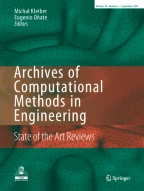
Machine learning (ML) holds significant potential for predicting soil properties in geotechnical design but at the same time poses challenges, including those of how to easily examine the performance of an algorithm and how to select an optimal algorithm. This study first comprehensively reviewed the application of ML algorithms in modelling soil properties for geotechnical design. The algorithms were categorized into several groups based on their principles, and the main characteristics of these ML algorithms were summarized. After that six representative algorithms are further detailed and selected for the creation of a ML-based tool with which to easily build ML-based models. Interestingly, automatic determination of the optimal configurations of ML algorithms is developed, with an evaluation of model accuracy, application of the developed ML model to the new data and investigation of relationships between the input variables and soil properties. Furthermore, a novel ranking index is proposed for the model comparison and selection, which evaluates a ML-based model from five aspects. Soil maximum dry density is selected as an example to allow examination of the performance of different ML algorithms, the applicability of the tool and the model ranking index to determining an optimal model.
This is a preview of subscription content, log in via an institution to check access.
Access this article
Subscribe and save
Springer+ Basic
€32.70 /Month
- Get 10 units per month
- Download Article/Chapter or eBook
- 1 Unit = 1 Article or 1 Chapter
- Cancel anytime
Buy Now
Price includes VAT (France)
Instant access to the full article PDF.
Rent this article via DeepDyve
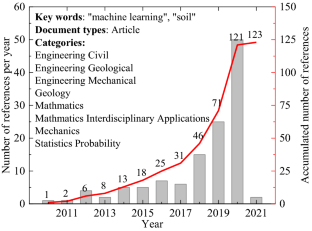
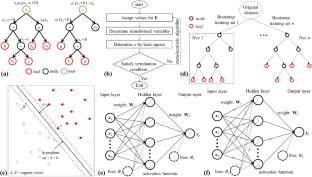
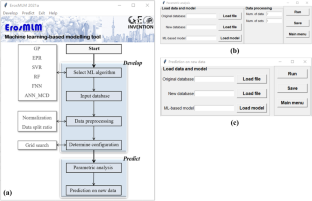
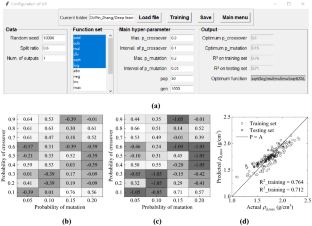
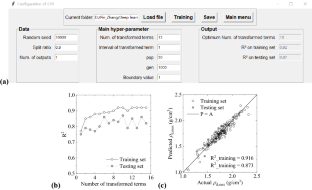
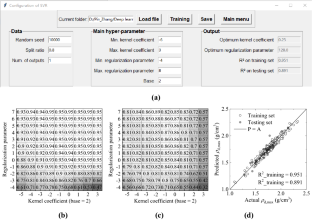
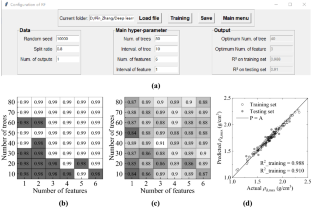

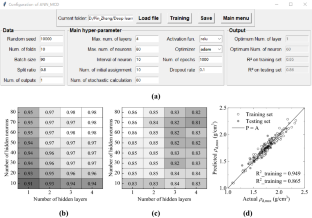
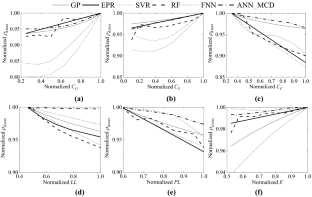
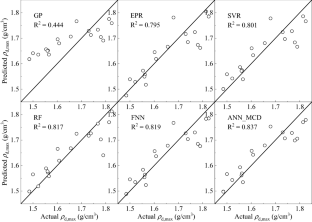
Similar content being viewed by others
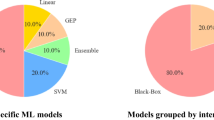
Developing Prediction Equations for Soil Resilient Modulus Using Evolutionary Machine Learning
Article 16 October 2023
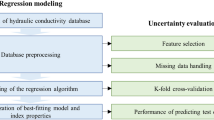
Prediction of hydraulic conductivity of sand with multivariate-index properties using optimal machine-learning-based regression models
Article 03 September 2024
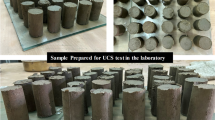
Applying Optimized Machine Learning Models for Predicting Unconfined Compressive Strength in Fine-Grained Soil
Article 08 February 2024
Explore related subjects
Abbreviations
Bias vector of the ith hidden layer
Constant coefficient vector
Number of iterations
Output of the ith hidden layer
Number of datasets
Number of features at each node
Dimension of input variables
Dimension of transformed variables
Number of decision trees
Stochastic calculation times
Probability of crossover
Probability of mutation
Size of population
Bernoulli distribution with probability of p
Weight matrix of the ith hidden layer
Maximum value of the variable xi
Minimum value of the variable xi
Normalized value of a dataset
Matrix of input variables
Matrix of transformed variables
Actual value of the output variable
Predicted value of the output variable
Mean value of the actual output variable
Output of the output layer
Slack parameter (default value: 0.1).
Mean value of output
References
- Yin JH (1999) Properties and behaviour of Hong Kong marine deposits with different clay contents. Can Geotech J 36(6):1085–1095 Google Scholar
- Nagaraj TS, Murthy BRS (1986) A critical reappraisal of compression index equations. Géotechnique 36(1):27–32 Google Scholar
- Ouyang Z, Mayne PW (2019) Modified NTH method for assessing effective friction angle of normally consolidated and overconsolidated clays from piezocone tests. J Geotech Geoenviron Eng 145(10):04019067 Google Scholar
- Hattab M, Hammad T, Fleureau JM (2015) Internal friction angle variation in a kaolin/montmorillonite clay mix and microstructural identification. Géotechnique 65(1):1–11 Google Scholar
- Yoon GL, Kim BT, Jeon SS (2004) Empirical correlations of compression index for marine clay from regression analysis. Can Geotech J 41(6):1213–1221 Google Scholar
- Kootahi K (2017) Simple index tests for assessing the recompression index of fine-grained soils. J Geotech Geoenviron Eng 143(4):06016027 Google Scholar
- Hayden CP, Purchase-Sanborn K, Dewoolkar M (2018) Comparison of site-specific and empirical correlations for drained residual shear strength. Géotechnique 68(12):1099–1108 Google Scholar
- Zhang P, Jin Y. F, Yin Z. Y, Yang Y (2020) Random forest based artificial intelligent model for predicting failure envelopes of caisson foundations in sand. Appl Ocean Res 101:102223
- Hochreiter S, Schmidhuber J (1997) Long short-term memory. Neural Comput 9(8):1735–1780 Google Scholar
- Krizhevsky A, Sutskever I, Hinton G, ImageNet classification with deep convolutional neural networks, NIPS, 2012
- LeCun Y, Bengio Y, Hinton G (2015) Deep learning. Nature 521:436–444 Google Scholar
- Shen S-L, Atangana Njock PG, Zhou A, Lyu H-M (2021) Dynamic prediction of jet grouted column diameter in soft soil using Bi-LSTM deep learning. Acta Geotech 16:303–315 Google Scholar
- Atangana Njock P.G., Shen S.-L., Zhou A., Lyu H.-M. (2020) Evaluation of soil liquefaction using AI technology incorporating a coupled ENN / t-SNE model. Soil Dyn Earthq Eng, 130:105988
- Lin S.-S., Shen S.-L., Zhang N., Zhou A. (2021) Comprehensive environmental impact evaluation for concrete mixing station (CMS) based on improved TOPSIS method. Sustainable Cities and Society, 69:102838
- Kohestani VR, Hassanlourad M (2016) Modeling the mechanical behavior of carbonate sands using artificial neural networks and support vector machines. Int J Geomech 16(1):04015038 Google Scholar
- Penumadu D, Zhao RD (1999) Triaxial compression behavior of sand and gravel using artificial neural networks (ANN). Comput Geotech 24:207–230 Google Scholar
- Zhang N., Shen S.-L., Zhou A., Jin Y.-F. (2021) Application of LSTM approach for modelling stress–strain behaviour of soil. Appl Soft Comput, 100:106959
- Zhang P, Yin ZY (2021) A novel deep learning-based modelling strategy from image of particles to mechanical properties for granular materials with CNN and BiLSTM. Comput Meth Appl Mech Eng 382:113858 MathSciNetMATHGoogle Scholar
- Zhang P, Wu HN, Chen R.P, Chan HT (2020) Hybrid meta-heuristic and machine learning algorithms for tunneling-induced settlement prediction: a comparative study. Tunnell Undergr Space Technol, 99:103383
- Zhang P, Yin ZY, Jin YF, Chan T, Gao FP (2021) Intelligent modelling of clay compressibility using hybrid meta-heuristic and machine learning algorithms. Geosci Front 12(1):441–452 Google Scholar
- Qi CC, Tang XL (2018) Slope stability prediction using integrated metaheuristic and machine learning approaches: a comparative study. Comput Ind Eng 118:112–122 Google Scholar
- Feng Y, Cui N, Hao W, Gao L, Gong D (2019) Estimation of soil temperature from meteorological data using different machine learning models. Geoderma 338:67–77 Google Scholar
- Zhang P, Yin ZY, Jin YF (2021) State-of-the-art review of machine learning applications in constitutive modeling of soils. Arch Comput Method Eng. https://doi.org/10.1007/s11831-020-09524-zArticleMathSciNetGoogle Scholar
- Elbaz K, Shen SL, Zhou AN, Yin ZY, Lyu HM (2021) Prediction of disc cutter life during shield tunnelling with AI via incorporation of genetic algorithm into GMDH-type neural network. Engineering 7(2):238–251 Google Scholar
- Gal Y., Ghahramani Z. (2015) Dropout as a Bayesian approximation: representing model uncertainty in deep learning. arXiv:1506.02142
- Blundell C., Cornebise J., Kavukcuoglu K., Wierstra D. (2015) Weight uncertainty in neural networks. arXiv:1505.05424v2
- Graves A. (2011) Practical variational inference for neural networks. NIPS
- Zhang P, Jin YF, Yin ZY (2021) Machine learning–based uncertainty modelling of mechanical properties of soft clays relating to time-dependent behavior and its application. Int J Numer Anal Methods Geomech. https://doi.org/10.1002/nag.3215ArticleGoogle Scholar
- Tan F, Zhou W-H, Yuen K-V (2018) Effect of loading duration on uncertainty in creep analysis of clay. Int J Numer Anal Methods Geomech 42(11):1235–1254 Google Scholar
- Zhou WH, Tan F, Yuen KV (2018) Model updating and uncertainty analysis for creep behavior of soft soil. Comput Geotech 100:135–143 Google Scholar
- Tan F, Zhou W-H, Yuen K-V (2016) Modeling the soil water retention properties of same-textured soils with different initial void ratios. J Hydrol 542:731–743 Google Scholar
- Zhou W-H, Yuen K-V, Tan F (2014) Estimation of soil–water characteristic curve and relative permeability for granular soils with different initial dry densities. Eng Geol 179:1–9 Google Scholar
- Zhang W, Goh ATC (2016) Multivariate adaptive regression splines and neural network models for prediction of pile drivability. Geosci Front 7(1):45–52 Google Scholar
- Cheng Z.-L, Zhou W.-H, Garg A (2020) Genetic programming model for estimating soil suction in shallow soil layers in the vicinity of a tree. Eng Geol, 268:105506
- Yin ZY, Jin YF, Huang HW, Shen SL (2016) Evolutionary polynomial regression based modelling of clay compressibility using an enhanced hybrid real-coded genetic algorithm. Eng Geol 210:158–167 Google Scholar
- Wang R, Zhang K, Wang W, Meng Y, Yang L, Huang H (2020) Hydrodynamic landslide displacement prediction using combined extreme learning machine and random search support vector regression model. Eur J Environ Civ Eng:1–13
- Samui P, Sitharam TG (2008) Least-square support vector machine applied to settlement of shallow foundations on cohesionless soils. Int J Numer Anal Met 32(17):419–427 MATHGoogle Scholar
- Ai L, Fang NF, Zhang B, Shi ZH (2013) Broad area mapping of monthly soil erosion risk using fuzzy decision tree approach: integration of multi-source data within GIS. Int J Geogr Inf Sci 27(6):1251–1267 Google Scholar
- Qi C, Fourie A, Zhao X (2018) Back-analysis method for stope displacements using gradient-boosted regression tree and firefly algorithm. J Comput Civil Eng 32(5):04018031 Google Scholar
- Zhang P, Yin Z.Y, Jin YF, Chan THT (2020) A novel hybrid surrogate intelligent model for creep index prediction based on particle swarm optimization and random forest. Eng Geol, 265:105328
- Sanikhani H, Deo RC, Yaseen ZM, Eray O, Kisi O (2018) Non-tuned data intelligent model for soil temperature estimation: a new approach. Geoderma 330:52–64 Google Scholar
- Yamaç SS, Şeker C, Negiş H (2020) Evaluation of machine learning methods to predict soil moisture constants with different combinations of soil input data for calcareous soils in a semi arid area. Agric Water Manage, 234:106121
- Chen RP, Zhang P, Kang X, Zhong ZQ, Liu Y, Wu HN (2019) Prediction of maximum surface settlement caused by EPB shield tunneling with ANN methods. Soils Found 59(2):284–295 Google Scholar
- Yilmaz I, Marschalko M, Bednarik M, Kaynar O, Fojtova L (2012) Neural computing models for prediction of permeability coefficient of coarse-grained soils. Neural Comput Appl 21(5):957–968 Google Scholar
- Kiefa MAA (1998) General regression neural networks for driven piles in cohesionless soils. J Geotech Geoenviron Eng 124(12):1177–1185 Google Scholar
- Feng X, Jimenez R (2015) Predicting tunnel squeezing with incomplete data using Bayesian networks. Eng Geol 195:214–224 Google Scholar
- Goh ATC, Kulhawy FH, Chua CG (2005) Bayesian neural network analysis of undrained side resistance of drilled shafts. J Geotech Geoenviron Eng 131(1):84–93 Google Scholar
- Koza JR (1992) Genetic programming: on the programming of computers by natural selection, MIT Press. MA, Cambridge MATHGoogle Scholar
- Sette S, Boullart L (2001) Genetic programming: principles and applications. Eng Appl Artif Intel 14:727–736 Google Scholar
- Giustolisi O, Savic DA (2006) A symbolic data-driven technique based on evolutionary polynomial regression. J Hydroinform 8(4):235–237 Google Scholar
- Jin YF, Yin ZY (2020) Enhancement of backtracking search algorithm for identifying soil parameters. Int J Numer Anal Methods Geomech 44(9):1239–1261 Google Scholar
- Jin YF, Yin ZY (2020) An intelligent multi-objective EPR technique with multi-step model selection for correlations of soil properties. Acta Geotech 15(8):2053–2073 Google Scholar
- Yin ZY, Jin YF, Shen JS, Hicher PY (2018) Optimization techniques for identifying soil parameters in geotechnical engineering: comparative study and enhancement. Int J Numer Anal Methods Geomech 42(1):70–94 Google Scholar
- Cortes C, Vapnik V (1995) Support-vector networks. Mach Learn 20:273–297 MATHGoogle Scholar
- Breiman L (2001) Random forests. Mach Learn 45:5–32 MATHGoogle Scholar
- Breiman L (1996) Bagging predictors. Mach Learn 24(2):123–140 MATHGoogle Scholar
- Zhang P, Chen RP, Wu HN (2019) Real-time analysis and regulation of EPB shield steering using Random Forest. Automat Constr, 106:102860
- Rumelhart DE, Hinton GE, Williams RJ (1986) Learning representations by back-propagating errors. Nature 323(9):533–536 MATHGoogle Scholar
- Srivastava N, Hinton G, Krizhevsky A, Sutskever I, Salakhutdinov R (2014) Dropout: a simple way to prevent neural networks from overfitting. J Mach Learn Res 15:1929–1958 MathSciNetMATHGoogle Scholar
- Wang HL, Yin ZY (2020) High performance prediction of soil compaction parameters using multi expression programming. Eng Geol, 276:105758
- Ören AH (2014) Estimating compaction parameters of clayey soils from sediment volume test. Appl Clay Sci 101:68–72 Google Scholar
- Gurtug Y, Sridharan A (2004) Compaction behaviour and prediction of its characteristics of fine grained soils with particular reference to compaction energy. Soils Found 44(5):27–36 Google Scholar
- AI-Khafaji A.N. (1993) Estimation of soil compaction parameters by means of Atterberg limits. Q J Eng Geol 26:359–368 Google Scholar
- Luo G (2016) A review of automatic selection methods for machine learning algorithms and hyper-parameter values. Netw Model Anal Health Inform Bioinforma 5:18 Google Scholar
- Zhang P, Yin ZY, Jin YF, Ye GL (2020) An AI-based model for describing cyclic characteristics of granular materials. Int J Numer Anal Methods Geomech 44(9):1315–1335 Google Scholar
- Zorlu K, Gokceoglu C, Ocakoglu F, Nefeslioglu HA, Acikalin S (2008) Prediction of uniaxial compressive strength of sandstones using petrography-based models. Eng Geol 96(3–4):141–158 Google Scholar
Acknowledgements
This research was financially supported by the Research Grants Council (RGC) of Hong Kong Special Administrative Region Government (HKSARG) of China (Grant No.: 15220221, R5037-18F).















